A wide range of trees and shrubs extend garden interest beyond springtime blooms, but many of them do not provide year-round appeal. When the colors of autumn fade and our garden’s bare bones become stark in winter’s clear light, hedging can provide that extra bit of seasonal interest.
Evergreens, such as conifers or traditional hedging plants, can help hold a larger garden’s structure together in the winter months, when leaf fall exposes the bare bones of its design. Hedging can also create informal and colorful boundaries when other shrubs are bare, secure a garden’s edges and provide food and shelter for birds, insects and mammals visiting the garden. See how hedges can improve your winter garden.
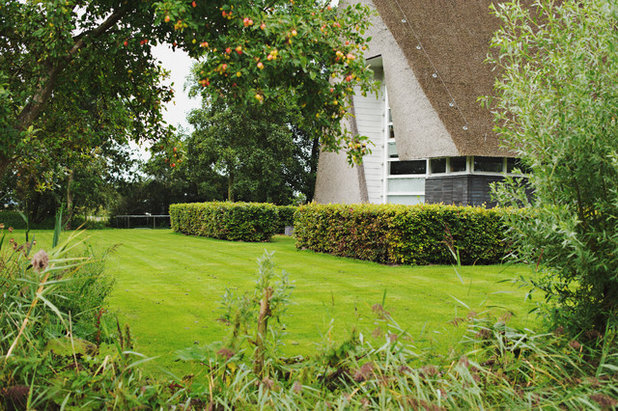
Boekel Tuinen
Hedges for Garden StructureWinter highlights every detail of a garden’s design, so creating structure within the garden can add interest through the hardest months. In formal gardens, such as those of the Arts and Crafts movement, hedges or brick walls created structure that formed intimate garden rooms.
Vita Sackville-West, the Edwardian English garden writer, wrote about creating “harlequin” hedges composed of yew, box, holly, beech and hornbeam to create wonderful winter interest via color and texture while retaining structure. “Like a green and black tartan,” she said.
- English yew (Taxus baccata, USDA zones 5 to 7; find your zone), with its dense, deep green foliage and ease of shaping, is a favorite for creating a strong geometrical barrier or division. It does tend to be slow growing, so it takes time to add required structure.
- European, or common, beech (Fagus sylvatica, zones 4 to 7) makes a superb garden hedge for winter color, though it is a tree not often seen in the U.S. As with the yew, it can be easily trained and shaped to form wonderful blocks of foliage within the landscape.
- Hornbeam (Carpinus betulus, zones 4 to 8) is one of the few plants that retains its dead leaves over winter, a trait called marcescence. The dry golden leaves may shimmer in the winter winds, but they will generally hold on until spring, when fresh new leaves appear, creating a year-round screen.

In the U.K., we’ve recently seen the increased use of broadleaf (
Griselinia littoralis, zones 9 to 10) as an evergreen hedge, especially in coastal locations, where it copes with the salt-laden conditions. In the winter it adds an evergreen richness to gardens, both with its texture and the way it emphasizes the garden’s structure with its height — it easily grows up to 10 feet tall. Broadleaf doesn’t produce flowers or berries over winter but brings joy through the variation of greens in its glossy green, rounded leaves and new shoots.
It is interesting to remember that green makes more of an impact in a garden during the winter, when the sun is lower in the sky, so having a hedge where the beauty is in the green foliage is not a disadvantage.
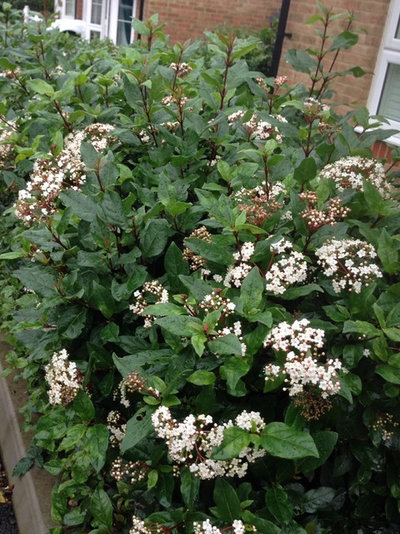 Hedges for Winter Color
Hedges for Winter ColorSome of us want more than just blocks of foliage, no matter how interesting the foliage is, to create a three-dimensional backbone to our garden design. We want flowers as well as the ability to create the shape and structure we require.
Laurustinus (
Viburnum tinus,
zones 7 to 10) fits this category well. It’s surprisingly hardy for a Mediterranean native, shrugging off sharp frosts when other supposedly hardier plants succumb. Depending on the variety, it will happily reach 10 feet tall but is easily pruned and contained to any height required to create a hedge.
Its outstanding feature is its ability to bear pink-tinged white flowers throughout the winter, finishing with an explosive burst of blossoms in the spring. Dark metallic-blue berries follow the flowers and nestle against the shiny, deep green foliage. Due to the plant’s nature of repeat flowering, both flowers and berries are found together through the winter.
The straight species is perfectly good as a hedging plant, but there are some very good varieties, such as ‘Gwenllian’, with its deep pink flowers; the compact ‘Eve Price’; and ‘French White’, which has amazing pure white flowers.
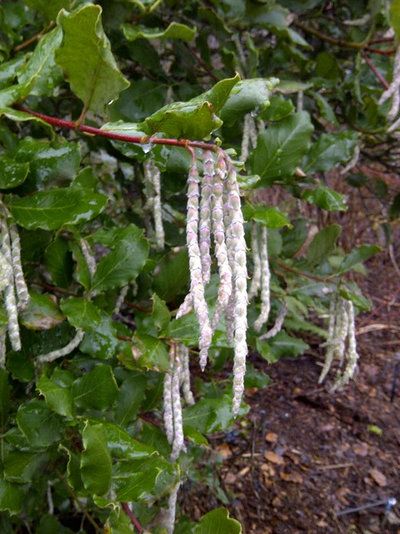
FROST NURSERY
Often grown as a wall shrub, California native coast silktassel (
Garrya elliptica, zones 4 to 9) can make a superb evergreen hedge. Its long, silver tasseled catkins that light up the midwinter garden are the jewel in silktassel’s crown, contrasting beautifully against the deep green leaves. If you grow it as a hedge, it’s advisable to prune early in the year to avoid cutting out the next year’s catkins. ‘James Roof’ has wonderful silky catkins that grow up to 8 inches long.
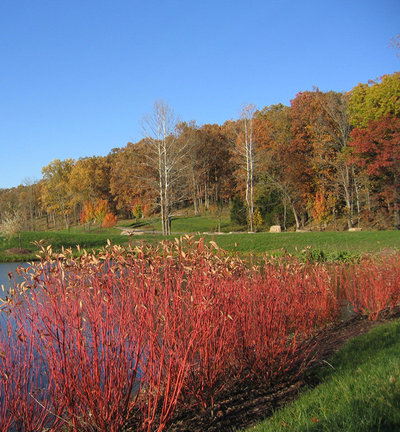
MTR Landscape Architects
Dogwoods (
Cornus spp)
provide us with some of the best hedging material for open, informal barriers. In the genus there are straight-stemmed and multistemmed specimens. Both can make winter hedges, though the nature of the multistemmed form helps create a tighter barrier. They don’t have to be set in straight lines, but they look much more effective when allowed to drift in long ribbons — even better when underplanted with evergreen low-growing plants.
This image shows
Cornus sericea ‘Cardinal’ (zones 3 to 7), a bright, red-stemmed variety of the North American native species. Its dark green foliage turns an attractive red-purple in the autumn before falling to uncover the glory of its multistemmed form. For bright yellow-green stems, it is worth looking for
Cornus sericea ‘Flaviramea’ (zones 3 to 7), a fast-growing Cornus that contrasts well with Cardinal in a mixed hedge.
See how to grow redtwig dogwood
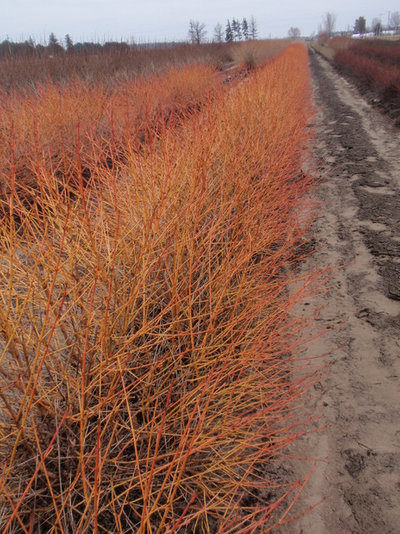
Proven Winners
It’s hard to beat the vivid yellow color of
Cornus ‘Arctic Sun’ (zones 3 to 7), a compact, multistemmed dogwood. The yellow stems become delightfully tipped with red over the winter and require a gentler pruning regime than some of the straight-stemmed species — generally just a gentle tidying in spring.
Cornus ‘Arctic Fire’ (zones 3 to 7) is its sister plant, and its bright red twiggy stems make for a great companion to the yellow ‘Arctic Sun’ in a mixed hedge. Both are well suited to the smaller garden.
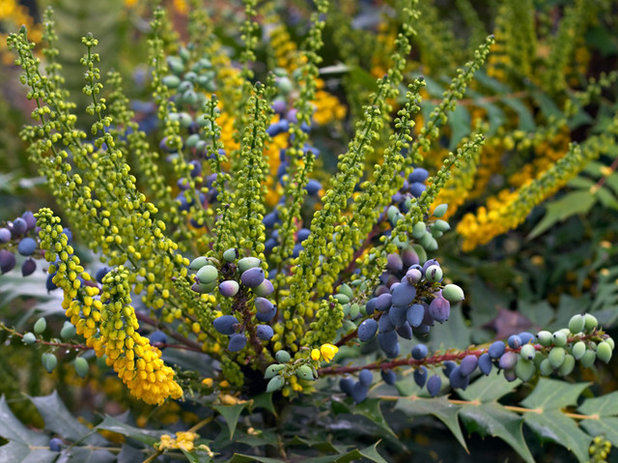
Monrovia
With its sharp-tipped, dark green foliage, Charity Oregon grape (
Mahonia x
media ‘Charity’, zones 7 to 9) creates a secure, decorative border for winter. It has a great architectural quality and can grow to over 6 feet tall, providing both structure and height to the garden. Its slightly fragrant, long yellow flowers are its real winter bonus. Its parentage includes
Mahonia japonica, which is actually from China; this gives it its hardiness and makes it very different in habit from the Oregon grape (
Mahonia aquifolium).
The aptly named
Mahonia x
media ‘Winter Sun’,
with its deliciously scented flowers, is a wonderful smaller variety.
 Hedges for Wildlife
Hedges for WildlifeThe berries of cotoneasters (
Cotoneaster spp) provide great autumn and winter color as well as feed insects, birds and small mammals. In autumn the small pink-tinged white flowers develop into a multitude of small red berries that pepper the plant, with some of the foliage turning from its normal dark green to a warm red in colder weather. It is also a great plant for wildlife, as its flowers provide food for bees and other pollinating insects, while the berries offer a tasty snack for birds on the coldest days.
Not all cotoneasters make good hedges. Some of the larger species, such as
Cotoneaster lacteus (zones 6 to 8) and
Cotoneaster salicifolius (zones 5 to 8), may be berry laden through winter and have wonderful foliage, but their size and loose growth habit make them unsuitable as hedging plants in the small garden. Simons’ cotoneaster (
Cotoneaster simonsii, zones 6 to 8) is not all that common in the U.S., but in the U.K., it has become popular as a hedging plant in smaller gardens or as a low boundary in front gardens. Though it will reach 10 feet tall, it can be easily controlled, and its normally loose straggly habit converted to a neat, tight hedge.
Caution: Cotoneasters could be considered invasive in rome regions; check its status in your area before planting.
Use these ideas and concepts to fit your garden, and select plants that are native to or will grow well in your region.
More:Feed the Birds: 6 Plants for Abundant Winter Berries
Look Beyond Plants for a Wonderful Winter Garden





